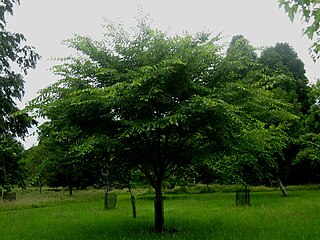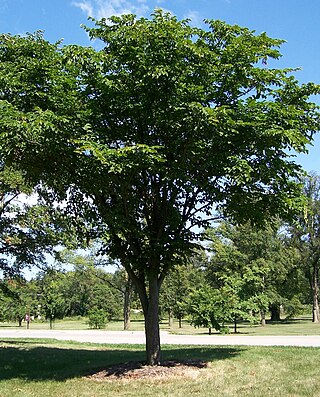Related Research Articles

Ulmus wallichianaPlanch., the Himalayan elm, also known as the Kashmir elm and Bhutan elm, is a mountain tree ranging from central Nuristan in Afghanistan, through northern Pakistan and northern India to western Nepal at elevations of 800–3000 m. Although dissimilar in appearance, its common name is occasionally used in error for the cherry bark elm Ulmus villosa, which is also endemic to the Kashmir, but inhabits the valleys, not the mountain slopes. The species is closely related to the wych elm U. glabra.

Ulmus davidiana var. japonica, the Japanese elm, is one of the larger and more graceful Asiatic elms, endemic to much of continental northeast Asia and Japan, where it grows in swamp forest on young alluvial soils, although much of this habitat has now been lost to intensive rice cultivation.
Ulmus bergmannianaC.K.Schneid., commonly known as Bergmann's elm, is a deciduous tree found across much of China in forests at elevations of 1500–3000 m.

Ulmus laciniata(Trautv.) Mayr, known variously as the Manchurian, cut-leaf, or lobed elm, is a deciduous tree native to the humid ravine forests of Japan, Korea, northern China, eastern Siberia and Sakhalin, growing alongside Cercidiphyllum japonicum, Aesculus turbinata, and Pterocarya rhoifolia, at elevations of 700–2200 m, though sometimes lower in more northern latitudes, notably in Hokkaido.

Ulmus macrocarpaHance, the large-fruited elm, is a deciduous tree or large shrub endemic to the Far East excluding Japan. It is notable for its tolerance of drought and extreme cold and is the predominant vegetation on the dunes of the Khorchin sandy lands in the Jilin province of north-eastern China, making a small tree at the base of the dunes, and a shrub at the top.

Ulmus changii, occasionally known as the Hangzhou elm, is a small deciduous tree found across much of China in forests at elevations of up to 1800 m. Owing to its increasing scarcity, U. changii was added to the Hainan Province Protected Plants List in 2006.
Ulmus glaucescensFranch., the Gansu elm, is a small deciduous tree from the northern provinces of China, where it is found along river valleys and on mountain slopes at elevations of 2000–2600 m.

Ulmus microcarpa was named and first described by the Chinese botanist L. K. Fu, who discovered the tree in the Chayu broad-leaved forests of south-eastern Xizang at altitudes of around 2800 m during the 1973 Qinghai - Tibet Expedition. Unlike the majority of Tibet, the Chayu region has a subtropical highland climate featuring warm, wet, summers and mild, dry, winters. Commonly known as the Tibetan Elm, the tree was introduced to the United States in 2006, and the UK in 2013; it remains one of the rarest species of elm in cultivation.
Ulmus chumlia is a small deciduous tree endemic to the Himalaya from the Kashmir to central Nepal, and the provinces of Yunnan, Sichuan and Xizang (Tibet) in China. It is found in broadleaf forest on mountain slopes at elevations of 1000–3000 m. Richens noted that the species appeared to be the same as that named by Grudzinskaya as Ulmus androssowii var. virgata, which she considered an intermediate between U. minor and U. pumila.

Ulmus davidiana, also known as the David elm, or Father David elm, is a small deciduous tree widely distributed across China, Mongolia, Korea, Siberia, and Japan, where it is found in wetlands along streams at elevations of 2000–2300 m (6,500–7,500 ft). The tree was first described in 1873 from the hills north of Beijing, China.
Ulmus pseudopropinquaWang & Li, occasionally known in the United States as the Harbin spring elm, is a small deciduous tree found only in Heilongjiang, the northeasternmost province in China. The tree has not been studied comprehensively, and it has been speculated it may be a natural hybrid of Ulmus davidiana var. japonica and Ulmus macrocarpa.

The Japanese elm cultivar Ulmus davidianavar.japonica 'Prospector' was originally treated as a cultivar of Wilson's elm U. wilsonianaSchneid., a species sunk as Ulmus davidiana var. japonica by Fu. A U.S. National Arboretum introduction, it was selected in 1975 from a batch of 1965 seedlings in Delaware, Ohio, and released without patent restrictions in 1990. 'Prospector' proved moderately successful in the US National Elm Trial, averaging a survival rate of 76% overall.

Ulmus laciniata var. nikkoensisRehder, the Nikko elm, was discovered as a seedling near Lake Chūzenji, near Nikkō, Japan, and obtained by the Arnold Arboretum in 1905. The taxonomy of the tree remains a matter of contention, and has been considered possibly a hybrid of U. laciniata and U. davidiana var. japonica. However, in crossability experiments at the Arnold Arboretum in the 1970s, U. laciniata, a protogynous species, was found to be incompatible with U. davidiana var. japonica, which is protandrous.
Ulmus bergmanniana var. lasiophyllaC. K. Schneid. is endemic to China, on mountain slopes at elevations of 2100–2900 m in Gansu, Shaanxi, north-west Sichuan, south-east Xizang, and north-west Yunnan.
Ulmus changii var. kunmingensisW. C. Cheng, occasionally referred to as the Kunming elm, is a Chinese tree endemic to montane forests at elevations of 600–1800 m in the provinces of Guangxi, Guizhou, Sichuan, and Yunnan.
Ulmus glaucescens var. lasiocarpaRehder, named the hairy-fruited glaucescent elm in the United States, is a Chinese tree found along rivers and mountain slopes at elevations of 2500–2600 m in the provinces of Hebei, Henan, Liaoning, Nei Mongol, Ningxia, eastern Qinghai, and Shanxi.
Ulmus davidiana var. davidiana is variety of elm. The tree is restricted to the Chinese provinces of Hebei, Henan, Shaanxi and Shanxi.

Ulmus parvifolia, commonly known as the Chinese elm or lacebark elm, is a species native to eastern Asia, including China, India, Japan, Korea, and Vietnam. It has been described as "one of the most splendid elms, having the poise of a graceful Nothofagus".
References
- ↑ Whittemore, A. T.; Fuller, R. S.; Brown, B. H.; Hahn, M.; Gog, L.; Weber, J. A.; Hipp, A. L. (2021). "Phylogeny, Biogeography, and Classification of the Elms (Ulmus)". Systematic Botany. 46 (3): 711–727. doi:10.1600/036364421X16312068417039. S2CID 240155250.
- ↑ Wiegrefe, S. J.; Sytsma, K. J.; Guries, R. P. (1994). "Phylogeny of elms (Ulmus, Ulmaceae): molecular evidence for a sectional classification". Systematic Botany. 19 (4): 590–612. doi:10.2307/2419779. JSTOR 2419779.
- ↑ Melville, R. & Heybroek, H. (1971). Elms of the Himalaya. Kew Bulletin, Vol. 26 (1). Kew, London.
- ↑ Tanai, T.; Wolfe, J. A. (1977). "Revisions of Ulmus and Zelkova in the middle and late Tertiary of western North America" (PDF). US Govt. Print. Off. 1026.